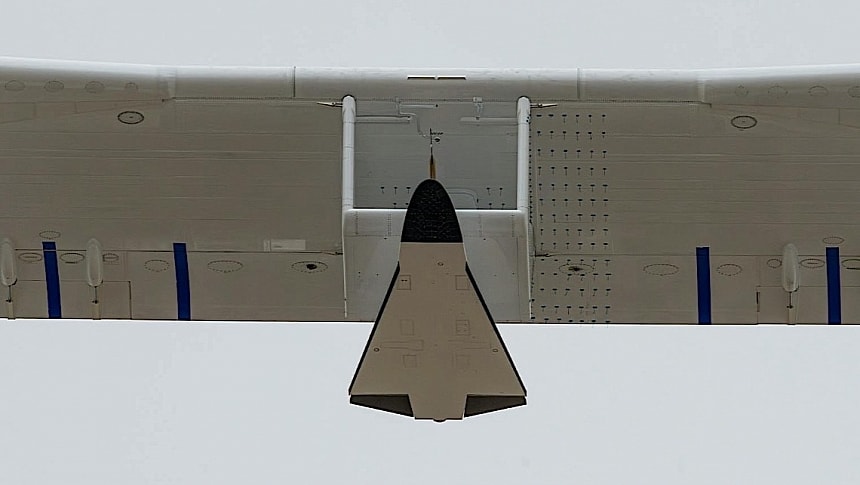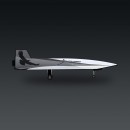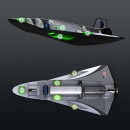About two months ago we got word of the first flight (kind of) of a hypersonic drone that's on the radar of the American military. Called TA-1, it is a precursor of a machine being developed by private company Stratolaunch as part of the Multi-Service Advanced Capability Hypersonic Test Bed (MACH-TB) program. And now we learn of it flying again, not on its own, but with help from a carrier plane.
The second test of the TA-1 was just announced by Stratolaunch, and it too comes with a premiere: it was the first one to be conducted at the Vandenberg Western Range, the likely location from where the first powered flight of the drone will take place.
I said the "first powered flight of the drone will take place" because this one was not it. Just like the trip to the sky in December 2023, the TA-1 flew attached to its carrier plane, the one the world knows as the Roc.
The contraption is a massive metal bird, spanning 385 feet (117 meters) from wingtip to wingtip and about the size of a football field lengthwise. In this respect, it is the world's largest operating aircraft. Powered by six Pratt & Whitney engines the likes of which the Boeing 747 is carrying, the plane is capable of lifting a total of 500,000 pounds (226,796 kg) of cargo.
The TA-1 is, of course, much lighter, but it's unclear by how much. During the first test flight of two months ago, the drone was attached to the Roc with fuel on board, and it was powered in a bid to test how it handles itself.
The same happened this time around, during the plane's 13th mission to the sky. The TA-1 was loaded with live propellant, and the primary goal of the mission was to evaluate the "flight environments." Telemetry and communications were also reviewed in preparation for the drone's first powered flight. The total duration of the mission was four hours and 29 minutes, greater than the three and a half hours spent in the air last time.
It's unclear when the first actual flight of the Talon-A will happen, but once it takes off, the hypersonic vehicle will probably change aviation forever. The system is to be used as a testbed for paying customers to research hardware and software at speeds above Mach 5 (3,800 mph/6,100 kph).
In the hands of the American military, the Talon will have to fly five times with payloads in a bid to prove it works. A new version of the drone will be used for the task, called TA-2. In this configuration, the missile-like aircraft is 28 feet (8.5 meters) long, and its wings spread over 11 feet (3.4 meters). The exact hardware that will power it is not known, other than it will use a Ursa Major Technologies engine called Hadley – a tech described by its maker as America's first oxygen-rich staged combustion engine.
I said the "first powered flight of the drone will take place" because this one was not it. Just like the trip to the sky in December 2023, the TA-1 flew attached to its carrier plane, the one the world knows as the Roc.
The contraption is a massive metal bird, spanning 385 feet (117 meters) from wingtip to wingtip and about the size of a football field lengthwise. In this respect, it is the world's largest operating aircraft. Powered by six Pratt & Whitney engines the likes of which the Boeing 747 is carrying, the plane is capable of lifting a total of 500,000 pounds (226,796 kg) of cargo.
The TA-1 is, of course, much lighter, but it's unclear by how much. During the first test flight of two months ago, the drone was attached to the Roc with fuel on board, and it was powered in a bid to test how it handles itself.
The same happened this time around, during the plane's 13th mission to the sky. The TA-1 was loaded with live propellant, and the primary goal of the mission was to evaluate the "flight environments." Telemetry and communications were also reviewed in preparation for the drone's first powered flight. The total duration of the mission was four hours and 29 minutes, greater than the three and a half hours spent in the air last time.
It's unclear when the first actual flight of the Talon-A will happen, but once it takes off, the hypersonic vehicle will probably change aviation forever. The system is to be used as a testbed for paying customers to research hardware and software at speeds above Mach 5 (3,800 mph/6,100 kph).
In the hands of the American military, the Talon will have to fly five times with payloads in a bid to prove it works. A new version of the drone will be used for the task, called TA-2. In this configuration, the missile-like aircraft is 28 feet (8.5 meters) long, and its wings spread over 11 feet (3.4 meters). The exact hardware that will power it is not known, other than it will use a Ursa Major Technologies engine called Hadley – a tech described by its maker as America's first oxygen-rich staged combustion engine.



















